Managing Marble Quarry Waste: Opportunities and Challenges for Circular Economy Implementation
Abstract
1. Introduction
- Defective blocks which do not meet the quality standards, resulting from the presence of joints and cracks and poor choice of cutting geometry;
- Shapeless blocks, excessively irregular or characterized by inadequate volume for industrial-type processing;
- Offcuts, which occur when stone blocks with uneven surfaces are cut;
- Fine waste resulting from the mixing of water and dust generated during the cutting phase (from diamond wire cutting machine, toothed chainsaw, etc.).
- Aggregates, which are very important for the European industry because of their wide application fields such as aggregates for concrete used in the construction, building and infrastructure sector [10,11,12,13], railway ballast used in railway construction, bituminous aggregate for road construction, and aggregate for subfloor layers used in railway and road construction;
- Industrial minerals [14,15], crucial for a country’s development across various sectors. They find applications in construction (clay for bricks, calcium carbonate for mortars and gypsum for plasterboard), industries (feldspar, kaolin and quartz for ceramics and glass), and environmental use (such as clay/bentonite as a waterproof material for landfills);
- Artificial substrates (namely technosols) for environmental and quarry rehabilitation, employing quarry sludge (especially silicate sludge) with soil and/or organic waste materials such as composted municipal waste and green manure [16,17,18]. Other studies have investigated their employment as soil fertilizer, as a waterproof material for landfills, etc. [19];
- Raw materials and critical raw materials (RM/CRMs), crucial for the EU economy and industrial development. Ni, for example, is used for Ni-Cd batteries and in superalloys for electric power stations or for airplane turbines; Fe, employed in steel production, in the paint industry and for magnet production; Al in car and airplane production; Cu for electric devices and line production; together with some CRMs which can be associated with them (e.g., PGEs associated with Ni; Cd, Ge, Ga, In associated with Zn-Pb ore deposits), as well as REE, the importance of which has increased over the last few decades [25].

2. The Carrara Marble Basin
2.1. Geological and Historical Setting
2.2. Recent Developments and Technological Innovations in the CMB
- Reducing the amount of excavation required for the same amount of marble extracted;
- Reducing the amount of waste material such as rubble, flakes and fragments, which would be produced if a broken and less “healthy” block were to be cut, thus optimizing production and increasing the yield percentage in excavated blocks. In the Apuan Alps marble district, the average yield of a quarry is estimated to be between 20 percent and 50 percent in terms of marketable marble blocks [54,60]. Resin application in quarries has the potential to boost this percentage (although an accurate estimate is not easy because it depends on the condition of the quarry—whether open-pit or tunnel—as well as the marble material and its state of fracturing);
- Increasing the safety of the operator in the quarry (a fragmented and unreinforced bench may not follow a predictable pattern during tipping);
- Making the transport of extracted blocks to processing plants safer.
2.3. Fine Waste and Sludge from Carrara Marble Basin (CMB)
- Fine waste produced by marble quarrying using a toothed chainsaw (Figure 5a) results in dry powder due to the absence of water during cutting operations, consisting mainly of very fine particles of rocks (varying in size from sand to silt) and sometimes, traces of oils and/or greases and hydrocarbons, accidentally leaking from the cutting machines or traces of metal resulting from the wear of cutting tools [63]. Also, as explained by [64,65], employing the toothed chainsaw generates a powder consisting of calcite with a grain size ranging from medium to fine sand (0.5–0.125 mm), consisting, microscopically, of sharp-edged granules and fracture surfaces concentrated along the cleavage planes. Finer granules (8–32 μm), probably generated by friction between the larger grains during cutting operations, can be recognized;
- The use of water during excavation (as occurs during the use of diamond wire technologies) mainly causes the formation of a sludge, or mud (Figure 5b), consisting of a mixture of water and the finest fraction of cutting residue (<62.5 μm; silt), but usually presents with the same appearance microscopically as the particles produced with the previous technology.
- Biological impact: Marble fine waste causes abrasion of the bodies and gills of macroinvertebrates and a reduction in food availability. As a result of the sedimentation of marble sludges, carbonate material is found on the riverbed, which hinders colonization, buries eggs and life stages attached to the substrate and destroys the diversity of microenvironments;
- Physical effects: marble sludge increases the degree of turbidity of river waters;
- Chemical effects: watercourses, deprived of the biological populations responsible for their self-purification, also carry a large part of the unchanged organic pollutant load.
3. Material and Methods
- Marble quarry sludge from primary marble excavation, mainly using diamond wire machines (wet sludge) and chainsaw cutters (microfine marble powder). The materials were sampled from a quarry from the Colonnata basin, and were collected immediately after the cutting phase, to preserve their original characteristics;
- Marble quarry sludge generated by processing the marble block once quarried (diamond wire squaring). The materials also come from a quarry in the Colonnata basin, and were sampled directly from sludge storage areas in the quarry area (e.g., settling tanks and/or filter bags);
- Marble sludge generated by marble squaring (also by diamond wire machines) in working plants (a necessary process for those blocks still retaining irregularities and requiring further resizing before the slab production phase with diamond frame-saws);
- Marble sludge deriving from treatment processes (filter-pressed sludge), both in working plants and recycling facilities in the Carrara area.
- Energy = 10 KeV;
- Beam current (BC) = 100 pA;
- Working distance (WD) = 6 mm;
- Scan speed = 4;
- Vacuum mode: HighVac (chamber pressure < 0.08 Pa).
4. Results
4.1. Preliminary Findings about CMB Extractive Industry (Marble and Waste Production)
4.2. Carrara Marble Sludge Characterization
5. Discussion and Conclusions
- Reduction in fine waste production through the use and implementation of dust extraction and storage facilities in the quarry, to be carried out immediately after the cutting phases;
- Monitoring the size, shape and chemical composition of inorganic particles that can be released in the air and also preventing the air dispersion of inorganic particles through irrigation;
- Attempting to implement and optimize new technologies of marble exploitation; for example, those for dry cutting, as already suggested in some studies [60]. Today, the machine used for dry cutting in CMB quarries is the diamond chainsaw, which produces residual materials with an irregular grain size, larger than that in the materials resulting from diamond wire cutting. Dry cutting with the latter is not possible today because, for safety reasons, the wire must be rubberized, and cutting without water would lead to the wire reaching temperatures incompatible with the rubber that covers it. In fact, water has a cooling and cleaning function. Dry cutting, therefore, could not only be functional in terms of saving water but also could be carried out with diamond wire in the production of higher-quality residual materials that can be immediately resold or reused;
- Improving waste management in the quarry, using proper temporary waste storage areas. In fact, as we described in this paper, the waste accumulated in the open areas of the quarry, whether it is marble sludge or terre and tout-venant, is subject to meteoric runoff, with the inevitable pollution of surface water, groundwater and springs. Therefore, the implementation of appropriate surface water regulation works, monitoring of groundwater levels, and quality monitoring of surface and groundwater is required;
- The collection and treatment of cutting wastewater. The turbid water is recycled and directed to a treatment plant (in a quarry) utilizing an immersion pump and bag filters, while marble sludge is periodically delivered to an authorized waste disposal company. Because the recycling of 100% of the water is not possible, and some of the water removed from production cycles is present in the waste fraction (sludge), it is urgent to ensure more efficient recycling, and develop more water treatment technologies (e.g., filter press technologies, decanters, etc.);
- Avoid dumping waste and debris on slopes inside the ravaneti, as described above. In fact, ravaneti, due to their high marble sludge and soil content, are also a very significant source of surface water, groundwater and spring pollution.
- Planned management and organization of quarrying activity: Start with a comprehensive understanding of mineral resources to plan land use and manage productivity effectively. A high level of knowledge about the deposit and its territory is indispensable for improving stone extraction;
- Stone characterization: The performance and productivity of a quarry is highly dependent on the type of machine used, which, in turn, is a function of rock characteristics. Machine specifications are generally readily known, but structural rock properties are not always readily available. The state of natural stress state and the fracturing of rock masses are key points in defining the possibility of extracting blocks of suitable size and volume. Structural anisotropy is a key control of the mechanical behavior of rocks under different environmental conditions, and the interaction between the crystal texture and its brittle mechanical behavior must be properly considered through appropriate laboratory tests. Indeed, if the extraction method causes significant fracturing of the stone blocks, alternative methods should be considered. It is therefore critical to conduct geotechnical investigations during the planning of work, combining the local structural features (for example, with rock fracture mapping) with the regional tectonic setting, to better understand the tectonic stress, local geological structures and morphology of the deposit. The workability of a rock is also linked to its textural characteristics and to its mineralogical composition. Therefore, the texture of the stone is another important factor to consider in the choice of cutting technology;
- Reduction in quarry waste “at the source” and “best practices”: The ratio between the blocks above a minimum volume and the total rock extraction determines the quantity of the extractive waste. There is a need to reduce waste production within the quarry through the adoption of the best available exploitation techniques. At the same time, it is essential to focus on the collection of fine waste and sludge “at the source”. As shown in this research, waste from Carrara marble exploitation may consist of pure CaCO3 that is already pulverized, essentially being a semi-finished by-product for later applications as filler. The proper collection and management of waste in quarry areas, avoiding contamination with other materials, is a crucial step toward sustainable waste management and a circular economy in the extractive industry. In addition, the effective management of quarries and extractive waste (EW) requires collaboration between companies that invest in dimension stone quarries and working plants, and public bodies at different governance levels and scales (regional, national and international), involving stakeholders, citizens, research and education;
- Characterization of quarry waste: The characterization of extractive waste is important for understanding if the cutting method is efficient, and for understanding which treatment is most suitable or necessary to transform this material into by-products that are reusable in other processes. The systematic recovery of quarry waste could provide important benefits, reducing the economic and environmental costs related to their management and transport;
- Research and promote reuse of rock wastes: in addition to good practices and waste characterization, it is necessary to find “downstream” markets willing to accept these wastes as “new products.” It is also necessary to inform and raise awareness of the need to accept and use products from the treatment of quarry waste (End of Waste Criteria);
- Environmental compatibility and sustainability: ensure the environmental compatibility and sustainability of mining and the extractive industry through the entire process: the evaluation of quarry planning, improvement of environmental performance during operations, and complete rehabilitation of the site at the end of operations;
- Four helices approach in managing issues connected to extractive waste management, and quarry management at large: cooperation and discussion among companies, public authorities, research centers and citizens.
Author Contributions
Funding
Data Availability Statement
Acknowledgments
Conflicts of Interest
References
- Gambino, F.; Borghi, A.; d’Atri, A.; Gallo, L.M.; Ghirardi, L.; Giardino, M.; Martire, L.; Palomba, M.; Perotti, L.; Macadam, J. TOURinSTONES: A Free Mobile Application for Promoting Geological Heritage in the City of Torino (NW Italy). Geoheritage 2019, 11, 3–17. [Google Scholar] [CrossRef]
- Barale, L.; Gambino, F.; Borghi, A.; d’Atri, A.; Piana, F. Ornamental Stones of Piemonte (NW Italy): An updated geo-lithological map. J. Maps 2020, 16, 867–878. [Google Scholar] [CrossRef]
- Samarakoon, K.G.A.U.; Chaminda, S.P.; Jayawardena, C.L.; Dassanayake, A.B.N.; Kondage, Y.S.; Kannangara, K.A.T.T. A Review of Dimension Stone Extraction Methods. Mining 2023, 3, 516–531. [Google Scholar] [CrossRef]
- Montani, C. XXXL Report Marble and Stones in the World 2020; Aldus: Carrara, Italy, 2020. [Google Scholar]
- Jalalian, M.H.; Bagherpour, R.; Khoshouei, M. Wastes production in dimension stones industry: Resources, factors, and solutions to reduce. Environ. Earth Sci. 2021, 80, 560. [Google Scholar] [CrossRef]
- Marras, G.; Carcangiu, G.; Meloni, P.; Careddu, N. Circular economy in marble industry: From stone scraps to sustainable water-based paints. Constr. Build. Mater. 2022, 325, 126768. [Google Scholar] [CrossRef]
- Ashmole, I.; Motloung, M. Dimension Stone: The Latest Trends In Exploration and Production Technology. In Proceedings of the International Conference on Surface Mining, Johannesburg, South Africa, 5–8 August 2008. [Google Scholar]
- EUROSTAT 2021. Eurostat Statistic Explained—Waste Generation. Waste statistics-Statistics Explained. Available online: https://ec.europa.eu/eurostat/statistics-explained/index.php?title=Waste_statistics (accessed on 2 April 2024).
- European Commission. Extractive Waste Directive 2006/21/EC. Directive 2006/21/EC of the European Parliament and of the Council of 15 March 2006 on the Management of Waste from Extractive Industries and Amending Directive 2004/35/EC; European Commission: Brussels, Belgium, 2006. [Google Scholar]
- André, A.; de Brito, J.; Rosa, A.; Pedro, D. Durability performance of concrete incorporating coarse aggregates from marble industry waste. J. Clean. Prod. 2014, 65, 389–396. [Google Scholar] [CrossRef]
- Ahmed, H.M.; Abdelhaffez, G.S.; Ahmed, A.A. Potential use of marble and granite solid wastes as environmentally friendly coarse particulate in civil constructions. Int. J. Environ. Sci. Technol. 2022, 19, 889–896. [Google Scholar] [CrossRef]
- Dias, A.B.; Pacheco, J.N.; Silvestre, J.D.; Martins, I.M.; de Brito, J. Environmental and economic life cycle assessment of recycled coarse aggregates: A Portuguese case study. Materials 2021, 14, 5452. [Google Scholar] [CrossRef]
- Luodes, H.; Kauppila, P.M.; Luodes, N.; Aatos, S.; Kallioinen, J.; Luukkanen, S.; Aalto, J. Characteristics and the environmental acceptability of the natural stone quarrying waste rocks. Bull. Eng. Geol. Environ. 2012, 71, 257–261. [Google Scholar] [CrossRef]
- Dino, G.A.; Cavallo, A.; Rossetti, P.; Garamvölgyi, E.; Sándor, R.; Coulon, F. Towards Sustainable Mining: Exploiting Raw Materials from Extractive Waste Facilities. Sustainability 2020, 12, 2383. [Google Scholar] [CrossRef]
- Silva, A.C.; Divino Carolina, S.; Nascimento Sousa, D.; SchonsSilva, E.M. Feldspar production from dimension stone tailings for application in the ceramic industry. J. Mater. Res. Technol. 2018, 8, 1–7. [Google Scholar] [CrossRef]
- Barrientos, V.; Delgado, J.; Navarro, V.; Juncosa, R.; Falcón, I.; Vázquez, A. Characterization and geochemical–geotechnical properties of granite sawdust produced by the dimension stone industry of O Porriño (Pontevedra, Spain). Q. J. Eng. Geol. Hydrogeol. 2010, 43, 141–155. [Google Scholar] [CrossRef]
- Marras, G.; Bortolussi, A.; Siotto, G.; Surraco, M.; Careddu, N. Reduction of marble waste landfills through the enhancement of CaCO3. Key Eng. Mater. 2020, 40, 145–153. [Google Scholar] [CrossRef]
- Dino, G.A.; Passarella, I.; Ajmone-Marsan, F. Quarry rehabilitation employing treated residual sludge from dimension stone working plant. Environ. Earth Sci. 2014, 73, 7157–7164. [Google Scholar] [CrossRef]
- Careddu, N.; Marras, G. Marble processing for future uses of CaCO3-microfine dust: A study on wearing out of tools and consumable materials in stone working factories. Miner. Process. Extr. Metall. 2015, 36, 183–191. [Google Scholar] [CrossRef]
- Coppola, B.; Palmero, P.; Montanaro, L.; Tulliani, J.M. Alkali-activation of marble sludge: Influence of curing conditions and waste glass addition. J. Eur. Ceram. Soc. 2020, 40, 3776–3787. [Google Scholar] [CrossRef]
- Palmero, P.; Formia, A.; Tulliani, J.-M.; Antonaci, P. Valorisation of alumino-silicate stone muds: From wastes to source materials for innovative alkali-activated materials. Cem. Concr. Compos. 2017, 83, 251–262. [Google Scholar] [CrossRef]
- Al-Hamaiedeh, H.D.; Khushefati, W.H. Granite sludge reuse in mortar and concrete. J. Appl. Sci. 2013, 13, 444–450. [Google Scholar] [CrossRef]
- Allam, M.E.; Bakhoum, E.S.; Garas, G.L. Re-use of granite sludge in producing green concrete. ARPN J. Eng. Appl. Sci. 2014, 9, 2731–2737. [Google Scholar]
- Al-Zboon, K.; Al-Zou’by, J. Recycling of stone cutting slurry in concrete mixes. J. Mater. Cycles Waste 2015, 17, 324–335. [Google Scholar] [CrossRef]
- Edraki, M.; Baumgartl, T.; Manlapig, E.; Bradshaw, D.; Franks, D.M.; Moran, C.J. Designing mine tailings for better environmental, social and economic outcomes: A review of alternative approaches. J. Clean. Prod. 2014, 84, 411–420. [Google Scholar] [CrossRef]
- Cavallo, A.; Dino, G.A. Extractive Waste as a Resource. Quartz, Feldspars, and Rare Earth Elements from Gneiss Quarries of the Verbano-Cusio-Ossola Province (Piedmont, Northern Italy). Sustainability 2022, 14, 4536. [Google Scholar] [CrossRef]
- Mehta, D.; Palwal, D.; Sankhla, V.S. Marble Waste Management for Protection of Ecology and Environment. IJISET 2020, 7, 2348–7968. [Google Scholar]
- Careddu, N.; Dino, G.A. Reuse of residual sludge from stone processing: Differences and similarities between sludge coming from carbonate and silicate stones-Italian experiences. Environ. Earth Sci. 2016, 75, 1075. [Google Scholar] [CrossRef]
- Gencel, O.; Nodehi, M.; Bayraktar, O.Y.; Kaplan, G.; Benli, A.; Koksal, F.; Bilir, T.; Siddique, R.; Ozbakkaloglu, T. The use of waste marble for cleaner production of structural concrete: A comprehensive experimental study. Constr. Build. Mater. 2022, 361, 129612. [Google Scholar] [CrossRef]
- Almeida, N.; Branco, F.; Santos, J.R. Recycling of stone slurry in industrial activities: Application to concrete mixture. Build. Environ. 2007, 42, 810–819. [Google Scholar] [CrossRef]
- Felekoglu, B. Utilisation of high volumes of limestone quarry wastes in concrete industry (self-compacting concrete case). Resour. Conserv. Recycl. 2007, 51, 770–791. [Google Scholar] [CrossRef]
- Topcu, I.B.; Bilir, T.; Uygunolu, T. Effect of waste marble dust content as filler on properties of self-compacting concrete. Constr. Build. Mater. 2009, 23, 1947–1953. [Google Scholar] [CrossRef]
- Gencel, O.; Koksal, F.; Erdogmus, E.; Martinez-Barrera, G.; Brostow, W. Properties of concrete paving blocks made with waste marble. J. Clean. Prod. 2012, 21, 62–67. [Google Scholar] [CrossRef]
- Dıaz, L.A.; Torrecillas, R. Porcelain stoneware obtained from the residual muds of serpentinite raw materials. J. Eur Ceram Soc. 2007, 27, 2341–2345. [Google Scholar] [CrossRef]
- Marras, G.; Careddu, N.; Internicola, C.; Siotto, G. Recovery and Reuse of Marble Powder By-Product. In Proceedings of the Global Stone Congress, Alicante, Spain, 2–5 March 2010. [Google Scholar]
- Devant, M.; Cusidó, J.A.; Soriano, C. Custom formulation of red ceramics with clay, sewage sludge and forest waste. Appl. Clay Sci. 2011, 53, 669–675. [Google Scholar] [CrossRef]
- Kushwah, R.P. Composite of marble slurry with Lime and White cement. IJREAM 2019, 5, 2454–9150. [Google Scholar]
- Lee, M.; Ko, C.; Chang, F.; Lo, S.; Lin, J.; Shan, M.; Lee, J. Artificial stone slab production using waste glass, stone fragments, and vacuum vibratory compaction. Cement. Concr. Compos. 2008, 30, 583–587. [Google Scholar] [CrossRef]
- Galetakis, M.; Alevizos, G.; Leventakis, K. Evaluation of fine limestone quarry by-products, for the production of building elements—An experimental approach. Constr. Build. Mater. 2012, 26, 122–130. [Google Scholar] [CrossRef]
- Barros, R.J.; Jesus, C.; Martins, M.; Costa, M.C. Marble stone processing powder residue as chemical adjuvant for the biologic treatment of acid mine drainage. Process Biochem. 2009, 44, 477–480. [Google Scholar] [CrossRef]
- Marras, G.; Bortolussi, A.; Peretti, R.; Careddu, N. Characterization methodology for re-using marble slurry in industrial applications. Energy Procedia 2017, 125, 656–665. [Google Scholar] [CrossRef]
- Giannecchini, R.; Galanti, Y.; Avanzi, G.D.; Barsanti, M. Probabilistic rainfall thresholds for triggering debris flows in a human-modified landscape. Geomorphology 2016, 257, 94–107. [Google Scholar] [CrossRef]
- Primavori, P. Carrara Marble: A nomination for ‘Global Heritage Stone Resource’ from Italy. Geol. Soc. Lond. Spec. Publ. 2015, 407, 137–154. [Google Scholar] [CrossRef]
- Molli, G.; Conti, P.; Giorgetti, G.; Meccheri, M.; Oesterling, N. Microfabric study on the deformational and thermal history of the Alpi Apuane marbles (Carrara marbles), Italy. J. Struct. Geol. 2000, 22, 1809–1825. [Google Scholar] [CrossRef]
- Molli, G.; Giorgetti, G.; Meccheri, M. Tectono-metamorphic evolution of the Alpi Apuane Metamorphic Complex: New data and constraints for geodynamic models. Boll. Soc. Geol. Ital. 2002, 1, 789–800. [Google Scholar]
- Vagnon, F.; Dino, G.A.; Umili, G.; Cardu, M.; Ferrero, A.M. New Developments for the Sustainable Exploitation of Ornamental Stone in Carrara Basin. Sustainability 2020, 12, 9374. [Google Scholar] [CrossRef]
- Carmignani, L.; Conti, P.; Fantozzi, P.; Meccheri, M.; Vaselli, L.; Mancini, S.; Massa, G.; Simoncini, D. Carta Giacimentologica dei Marmi delle Alpi Apuane a Scala 1:10.000 e sua Informatizzazione. Convention between Regione Toscana and Università di Siena (Centro di GeoTecnologie, CGT and Dipartimento di Scienze della Terra, Siena). Final Report. 2007. Available online: https://www.cai.it/wp-content/uploads/2019/09/carta.pdf (accessed on 22 March 2024).
- Barron, A.J. Carrara Marble. Mercian Geol. 2018, 19, 188–194. Available online: https://nora.nerc.ac.uk/id/eprint/524277 (accessed on 2 April 2024).
- Cantisani, E.; Fratini, F.; Molli, G.; Pandolfi, L. Sulla provenienza apuana del marmo di cippi funerari etruschi. In Conference Proceedings “Ante e Post Lunam, splendore e ricchezza dei marmi apuani, I—l’evo antico”, Carrara, Italy, 2003. Acta Apuana, vol. II, pp. 19–25. Available online: http://www.archeominerario.it/documenti/convarch1int.pdf (accessed on 4 April 2024).
- Fruzzetti, A. Dinamiche Strategico-Organizzative nel Settore Lapideo: Il Caso del Distretto Apuo-Versiliese. Master’s Thesis, Università di Pisa, Pisa, Italy, 2008. [Google Scholar]
- Franzini, M. La ripresa, in epoca medievale, dell’estrazione del marmo nella Toscana costiera. In Conference Proceedings “Ante et Post Lunam. Reimpiego e Ripresa Estrattiva dei Marmi Apuani: II—l’evo medio”, Carrara, Italy, 2005. Acta Apuana, vol. IV-V, pp. 45–57. Available online: http://www.archeominerario.it/documenti/convarch2int.pdf (accessed on 4 April 2024).
- Coli, M.; Criscuolo, A. The Carrara Marble: Geology, geomechanics and quarrying. IOP Conf. Ser. Earth Environ. Sci. 2021, 833, 012120. [Google Scholar] [CrossRef]
- Auletta, N. Caratterizzazione di Laboratorio Mirata All’analisi delle Prestazioni di Fili Diamantati per il Taglio di Materiali Carbonatici. Master’s Thesis, Politecnico di Torino, Turin, Italy, 2019. [Google Scholar]
- Piani Attuativi dei Bacini Estrattivi delle Alpi Apuane (“P.A.B.E”). Scheda n.14—Bacini di Carrara: Piscinicchi-Pescina Boccanaglia Bassa; Relazioni e Disciplina; A1.1 Quadro Conoscitivo Socio-Economico del Territorio e Della Filiera Lapidea ai Fini del PABE; Comune di Carrara: Carrara, Italy, 2019; Available online: http://servizi.comune.carrara.ms.it/PABE_pubblica/Scheda%2014%20PIT%20-%20Piano%20Attuativo%20Bacino%20Estrattivo%20di%20Pescina%20Boccanaglia%20e%20Piscinicchi/A%20-%20Relazioni%20e%20disciplina/A1.1_Quadro_conoscitivo_socio_economico_del_territorio_e_della_filiera_lapidea_ai_fini_del_PABE_d.pdf (accessed on 2 April 2024).
- Carmignani, L.; Meccheri, M.; Primavori, P. Marbles and other ornamental stones from the Apuane Alps (northern Tuscany, Italy). Ital. J. Appl. Geol. 2005, 1, 233–246. [Google Scholar] [CrossRef]
- López-Buendía, A.M.; Guillem, C.; Cuevas, J.M.; Mateos, F.; Montoto, M. Natural stone reinforcement of discontinuities with resin for industrial processing. Eng. Geol. 2013, 166, 39–51. [Google Scholar] [CrossRef]
- Zanzi, L.; Izadi-Yazdanabadi, M.; Karimi-Nasab, S.; Arosio, D.; Hojat, A. Time-Lapse GPR Measurements to Monitor Resin Injection in Fractures of Marble Blocks. Sensors 2023, 23, 8490. [Google Scholar] [CrossRef]
- Arndt, B.; DeMarco, M.; Andrew, R. Polyurethane Resin (PUR) Injection for Rock Mass Stabilization; Publication No. FHWA-CFL/TD-08-004; Central Federal Lands Highway Division: Lakewood, CO, USA, 2008. [Google Scholar]
- Tesser, E.; Lazzarini, L.; Bracci, S. Investigation on the chemical structure and ageing transformations of the cycloaliphatic epoxy resin EP2101 used as stone consolidant. J. Cult. Herit. 2018, 31, 72–82. [Google Scholar] [CrossRef]
- Gussoni, M. Roadmap Tecnologiche per la Specializzazione Intelligente del Settore Lapideo Toscano; Final report; Distretto Tecnologico Marmo e Pietre Ornamentali (DTeMPO): Carrara, Italy, 2018. [Google Scholar]
- Bakshi, P.; Pappu, A.; Patidar, R.; Gupta, M.K.; Thakur, V.K. Transforming Marble Waste into High-Performance, Water-Resistant, and Thermally Insulative Hybrid Polymer Composites for Environmental Sustainability. Polymers 2020, 12, 1781. [Google Scholar] [CrossRef]
- Legambiente Carrara. PABE Carrara: Osservazioni al Rapporto Preliminare IRTA. Carrara. 2018. Available online: https://www.legambientecarrara.it/2019/04/20/cave-sostenibili-solo-con-misure-radicali-osservazioni-al-rapporto-irta/ (accessed on 22 March 2024).
- Lezzerini, M.; Luti, L.; Aquino, A.; Gallello, G.; Pagnotta, S. Effect of Marble Waste Powder as a Binder Replacement on the Mechanical Resistance of Cement Mortars. Appl. Sci. 2022, 12, 4481. [Google Scholar] [CrossRef]
- Piccini, L.; Di Lorenzo, T.; Costagliola, P.; Galassi, D.M.P. Marble Slurry’s Impact on Groundwater: The Case Study of the Apuan Alps Karst Aquifers. Water 2019, 11, 2462. [Google Scholar] [CrossRef]
- De Rosa, G.M.L. Studio per la Realizzazione di un Sistema Esperto per il Monitoraggio in Continuo della Torbidità nei Corpi Idrici del Comprensorio Apuano2nd level specializing Master Course in Sistemi Informativi Geografici per il Monitoraggio e la Gestione del Territorio. Università degli Studi di Firenze: Firenze, Italy, 2019. [Google Scholar]
- Rapporto Annuale SUI Rifiuti in Toscana. Il Ciclo dei Rifiuti Speciali in Toscana, Dati 2002–2017, Firenze, Dicembre. 2019. Available online: https://www.arrr.it/documents/965920/978140/Rapporto+Annuale+sui+RS+2021.pdf/c1178d40-4ed7-4807-8792-57031f946da6 (accessed on 2 April 2024).
- Bianco, I. Life Cycle Inventory of Cutting Technologies in the Ornamental Stone Supply Chain. Ph.D. Thesis, Politecnico di Torino, Turin, Italy, 2018. [Google Scholar]
- ARPAT-Agenzia Regionale per la Protezione Ambientale della Toscana. Progetto Speciale Cave, Regione Toscana. 2016. Available online: https://www301.regione.toscana.it/bancadati/atti/Contenuto.xml?id=5135758&nomeFile=Delibera_n.1420_del_27-12-2016-Allegato-F (accessed on 2 April 2024).
- ARPAT—Agenzia Regionale per la Protezione Ambientale della Toscana. Impatto Ambientale-la Marmettola. Available online: https://www.arpat.toscana.it/temi-ambientali/sistemi-produttivi/attivita-estrattiva/impatto-ambientale-la-marmettola (accessed on 2 April 2024).
- Legambiente Carrara. “Dossier Marmettola: L’inquinamento Autorizzato”. 2016. Available online: https://www.legambientecarrara.it/2016/06/01/dossier-marmettola-linquinamento-autorizzato (accessed on 2 April 2024).
- Dundar, T.; Ayrilmis, N.; Akkus, M.; Ulay, G. Effect of the marble powder and wood powder content on the technological properties of thermoplastic composites. Mach. Technol. Mater. 2016, 10, 13–16. [Google Scholar]
- Khedr, S.; El-Haggar, S.; Hamza, R. Utilization of Marble and Granite Waste in Concrete Brick. In Proceedings of the International Conference on Environment and Bioscience IPCBEE, Singapore, 23–25 September 2011. [Google Scholar]
- Kore, S.D.; Vyas, A.K.; Kabeer, S.A.K.I. A brief review on sustainable utilisation of marble waste in concrete. Int. J. Sustain. Eng. 2019, 13, 1–16. [Google Scholar] [CrossRef]
- Hlubocký, L.; Prošek, Z. Mechanical Properties of Cement Composite with Material Based on Waste Marble Powder and Crushed Limestone. Adv. Mater. Res. 2017, 1144, 9–13. [Google Scholar] [CrossRef]
- Aukour, F.J.; Al-Qinna, M.I. Marble Production and Environmental Constrains: Case Study from Zarqa Governorate, Jordan. Jordan J. Earth Environ. Sci. 2008, 1, 11–21. [Google Scholar]
- Rabbani, M.B.A.; Khan, Q.Z.; Usama, U. Determination of Air Pollutants and Its Modeling: A Machine Learning Approach for Assessment of Air Quality in Industrial Estate, Hayatabad. In Proceedings of the 1st International Conference on Recent Advances in Civil and Earthquake Engineering, Peshawar, Pakistan, 8 October 2021. [Google Scholar]
- Cortopassi, P.F.; Daddi, M.; D’Amato, G.A.; Giannecchini, R.; Lattanzi, G.; Merlini, A.; Milano, P.F. Quarry waste and slope instability: Preliminary assessment of some controlling factors in the Carrara marble basin (Italy). Italian J. Eng. Geol. Environ. 2008, 99–118. [Google Scholar] [CrossRef]
- Mastrorocco, G.; Salvini, R.; Vanneschi, C. Fracture mapping in challenging environment: A 3D virtual reality approach combining terrestrial LiDAR and high-definition images. Bull. Eng. Geol. Environ. 2018, 77, 691–707. [Google Scholar] [CrossRef]
- Gulli, D.; Pellegri, M.; Marchetti, D. Mechanical behavior of Carrara marble rock mass related to geo-structural conditions and in-situ stress. In Proceedings of the 15th Pan-American Conference on Soil Mechanics and Geotechnical Engineering (PCSMGE)/8th South American Congress on Rock Mechanics (SCRM), Buenos Aires, Argentina, 15–18 November 2015; pp. 253–260. [Google Scholar]
- Gentili, R.; Sgorbati, S.; Baroni, C. Plant species patterns and restoration perspectives in the highly disturbed environment of the Carrara marble quarries (Apuan Alps, Italy). Restor. Ecol. 2011, 19, 32–42. [Google Scholar] [CrossRef]
- EN 12457-2; Caratterizzazione dei Rifiuti-Lisciviazione-Prova di Conformità per la Lisciviazione di Rifiuti Granulari e di Fanghi-Parte 2: Prova a Singolo Stadio, con un Rapporto Liquido/Solido di 10 l/kg, per Materiali con Particelle di Dimensioni Minori di 4 mm (con o Senza Riduzione delle Dimensioni). British Standards Institution: London, UK, 2004.
- UNI 10802; Rifiuti-Campionamento Manuale, Preparazione del Campione ed Analisi Degli Eluati. UNI-Italian National Standards Body: Rome, Italy, 2013.
- UNI EN 933-1; Prove per Determinare le Caratteristiche Geometriche degli Aggregati-Parte 1: Determinazione della Distribuzione Granulometrica-Analisi Granulometrica per Setacciatura. UNI-Italian National Standards Body: Rome, Italy, 2012.
- UNI EN 933-2; Prove per Determinare le Caratteristiche Geometriche degli Aggregati-Parte 2: Determinazione della Distribuzione Granulometrica-Setacci di Controllo, Dimensioni Nominali delle Aperture. UNI-Italian National Standards Body: Rome, Italy, 2020.
- ASTM D4318; Complete Document Standard Test Methods for Liquid Limit, Plastic Limit, and Plasticity Index of Soils. ASTM International: West Conshohocken, PA, USA, 2017.
- Piano Regionale delle Attività Estrattive di Recupero delle Aree Escavate e di Riutilizzo dei Residui Recuperabili (“P.R.A.E.R). Regional Council Resolution No. 27, Regione Toscana. 2007. Available online: https://www.regione.toscana.it/documents/10180/71336/Praer%20-%20Piano%20regionale%20delle%20attivit%C3%A0%20estrattive/340180db-f643-4306-952a-9e38c39388cf (accessed on 2 April 2024).
- Dhoka, M. Green Concrete Using Industrial Waste of Marble Powder, Quarry Dust and Paper Pulp. IJESI 2013, 2, 67–70. [Google Scholar]
- Singh, M.; Choudhary, K.; Srivastava, A.; Sangwan, K.S.; Bhunia, D. A study on environmental and economic impacts of using waste marble powder in concrete. J. Build. Eng. 2017, 13, 87–95. [Google Scholar] [CrossRef]
- Prabhu, G.G.; Hyun, J.H.; Kim, Y.Y. Effects of foundry sand as a fine aggregate in concrete production. Constr. Build. Mater. 2014, 70, 514–521. [Google Scholar] [CrossRef]
- Danish, A.; Mosaberpanah, M.A.; Salim, M.U.; Fediuk, R.; Rashid, M.F.; Waqas, R.M. Reusing marble and granite dust as cement replacement in cementitious composites: A review on sustainability benefits and critical challenges. J. Build. Eng. 2021, 44, 102600. [Google Scholar] [CrossRef]
- Mancini, S.; Casale, M.; Rossi, P.; Faraudello, A.; Dino, G.A. Operative instruments to support public authorities and industries for the supply of raw materials: A decision support tool to evaluate the sustainable exploitation of extractive waste facilities. Resour. Policy 2023, 81, 103338. [Google Scholar] [CrossRef]
- Bellenfant, G.; Guezennec, A.G.; Bodenan, F.; D’Hugues, P.; Cassard, D. Reprocessing of mining waste: Combining environmental management and metal recovery. In Proceedings of the Eighth International Seminar on Mine Closure; Tibbett, M., Fourie, A.B., Digby, C., Eds.; Australian Centre for Geomechanics: Cornwall, UK, 2013; pp. 571–582. [Google Scholar]
- Song, X.; Pettersen, J.B.; Pedersen, K.B.; Røberg, S. Comparative life cycle assessment of tailings management and energy scenarios for a copper ore mine: A case study in Northern Norway. J. Clean. Prod. 2017, 64, 892–904. [Google Scholar] [CrossRef]
- Beylot, A.; Bordenan, F.; Guezennec, A.-G.; Muller, S. LCA as a support to more sustainable tailings management: Critical review, lessons learnt and potential way forward. Resour. Conserv. Recycl. 2022, 183, 106347. [Google Scholar] [CrossRef]
- Maraboutis, P.; Poulimenou, N.I.; Nikolaou, E. How the Proper Management of Extractive Waste Can Support the Circular Economy. Mater. Proc. 2021, 5, 118. [Google Scholar] [CrossRef]
- Garbarino, E.; Orveillon, G.; Saveyn, H.G.M. Management of waste from extractive industries: The new European reference document on the Best Available Techniques. Resour. Policy 2020, 69, 101782. [Google Scholar] [CrossRef]
- Maraboutis, P.; Poulimenou, N.-I.; Nikolaou, E. Risk Management: An Essential “Tool” for the Extractive Sector. Mater. Proc. 2021, 5, 119. [Google Scholar] [CrossRef]
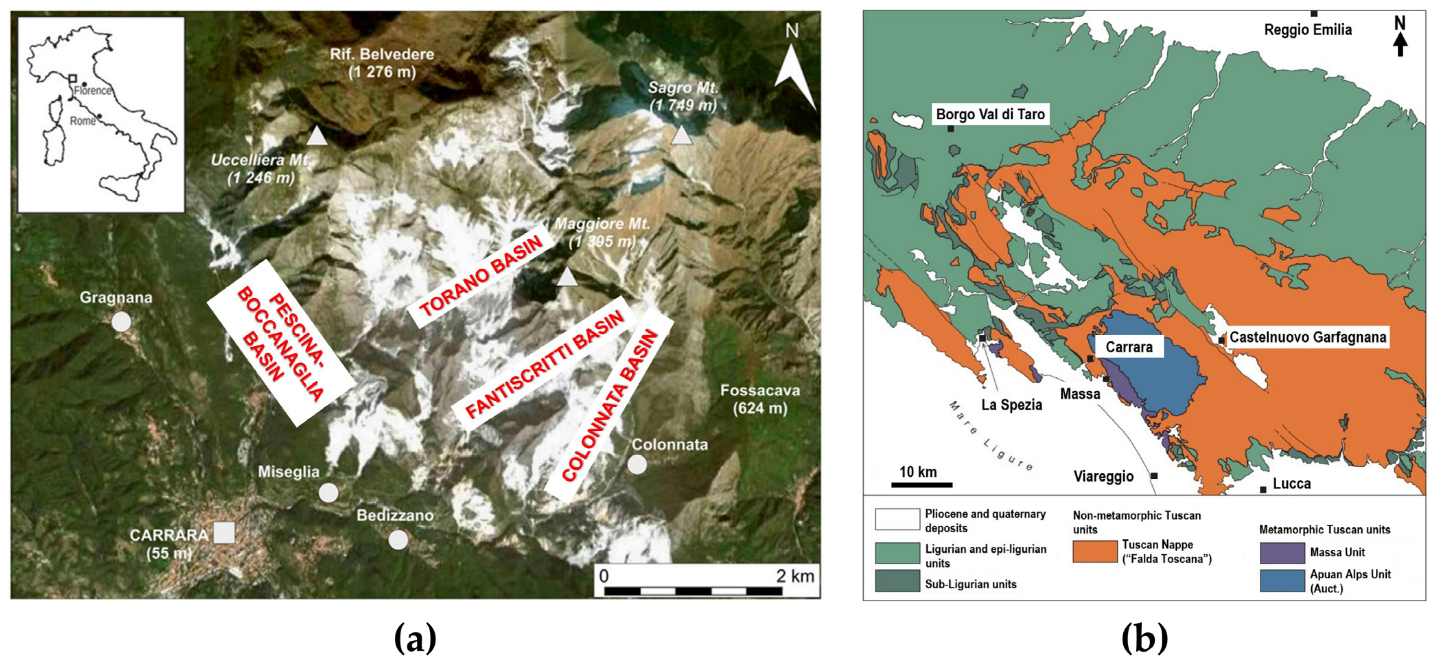
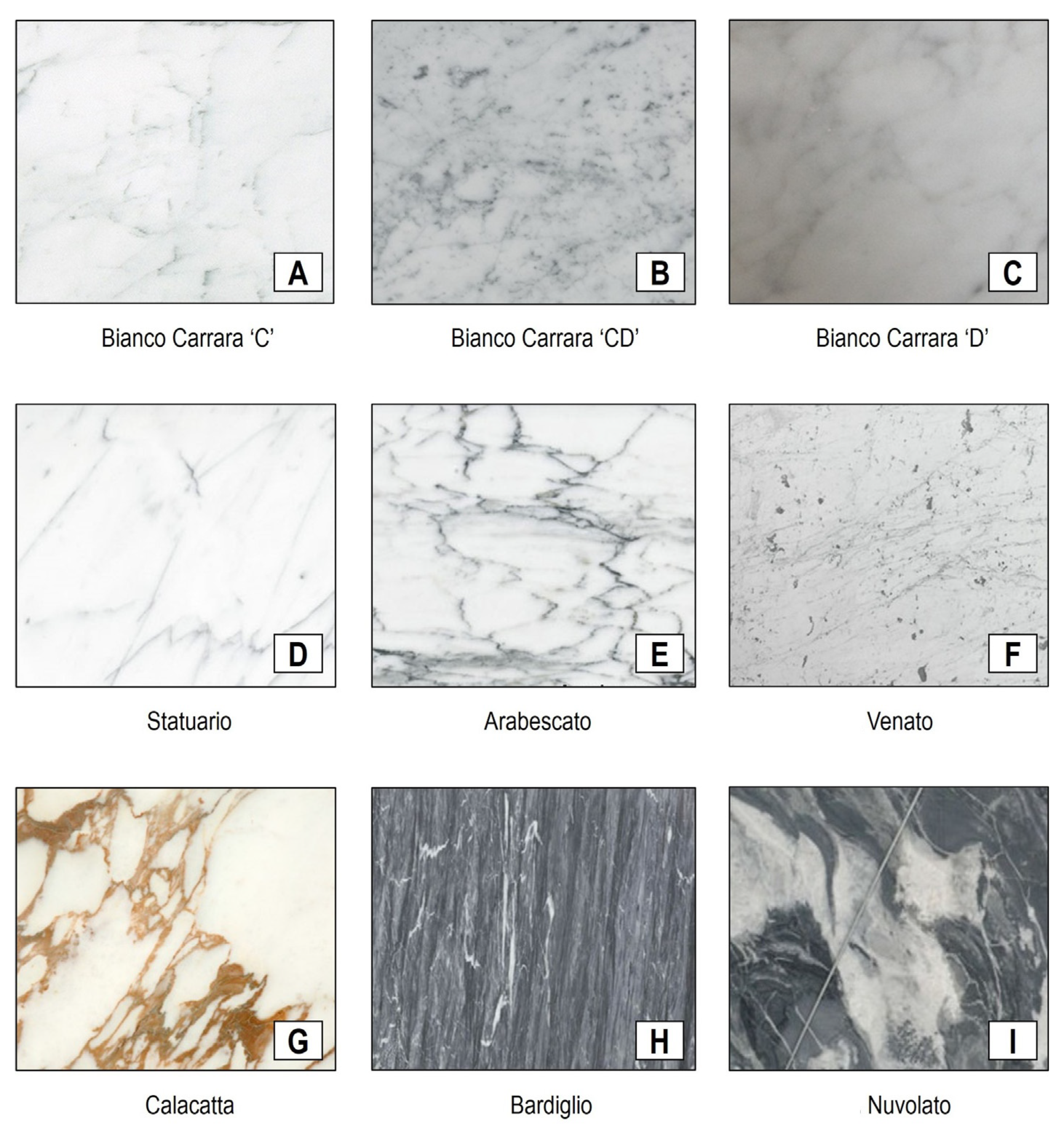
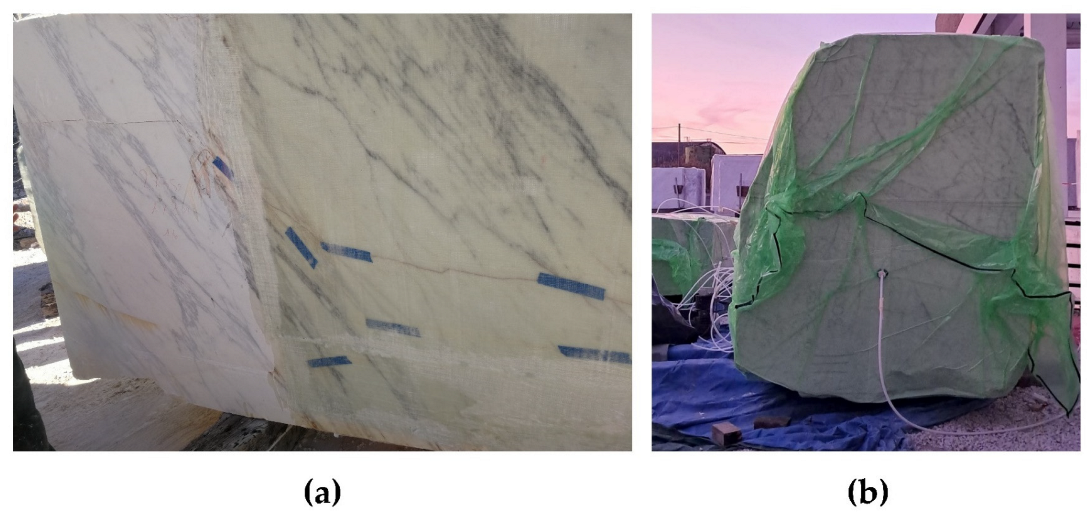
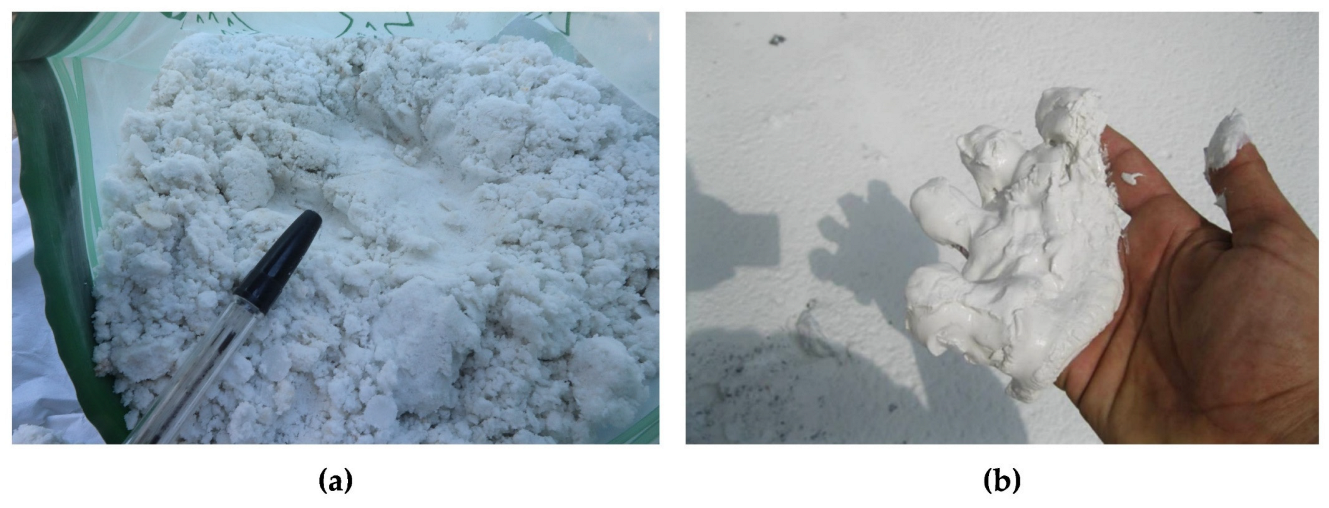
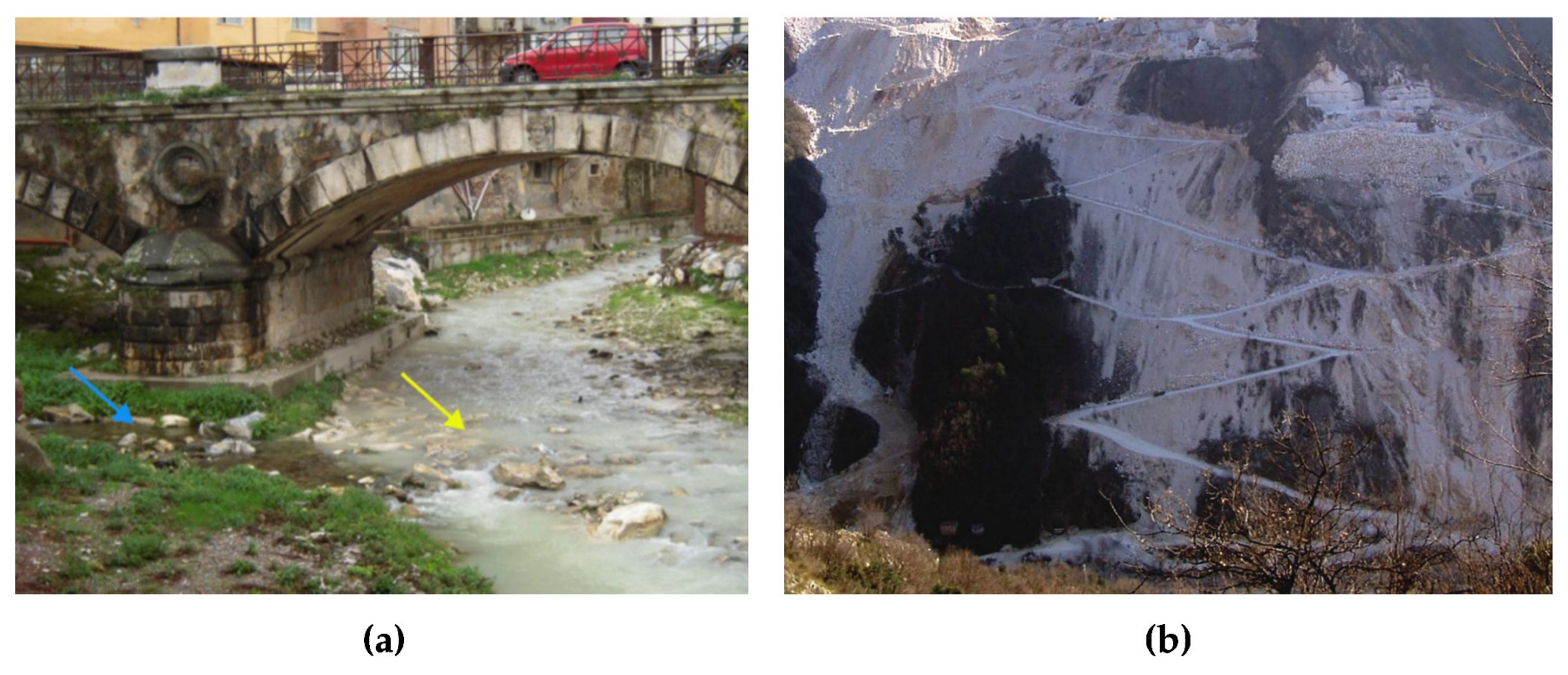

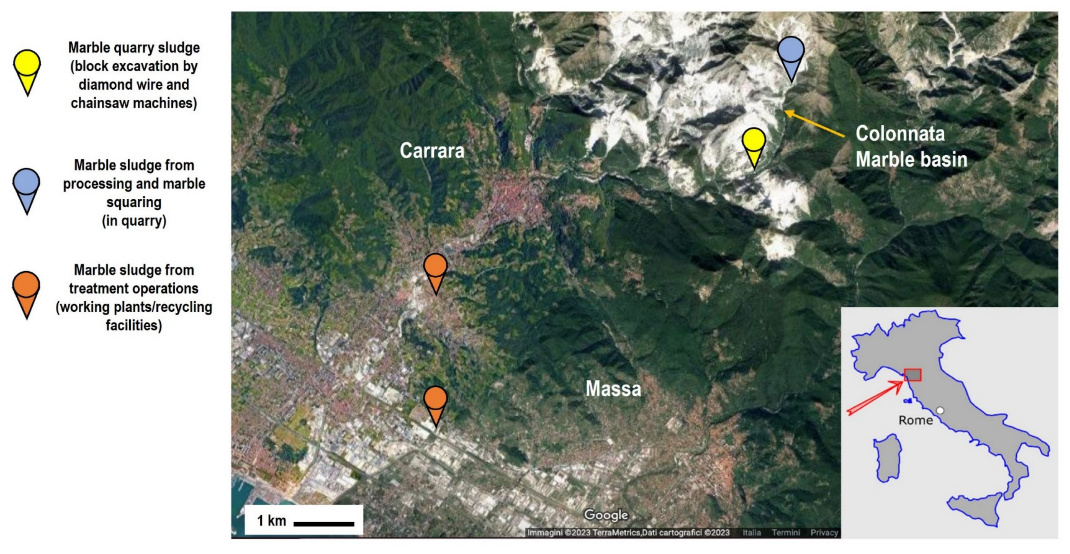
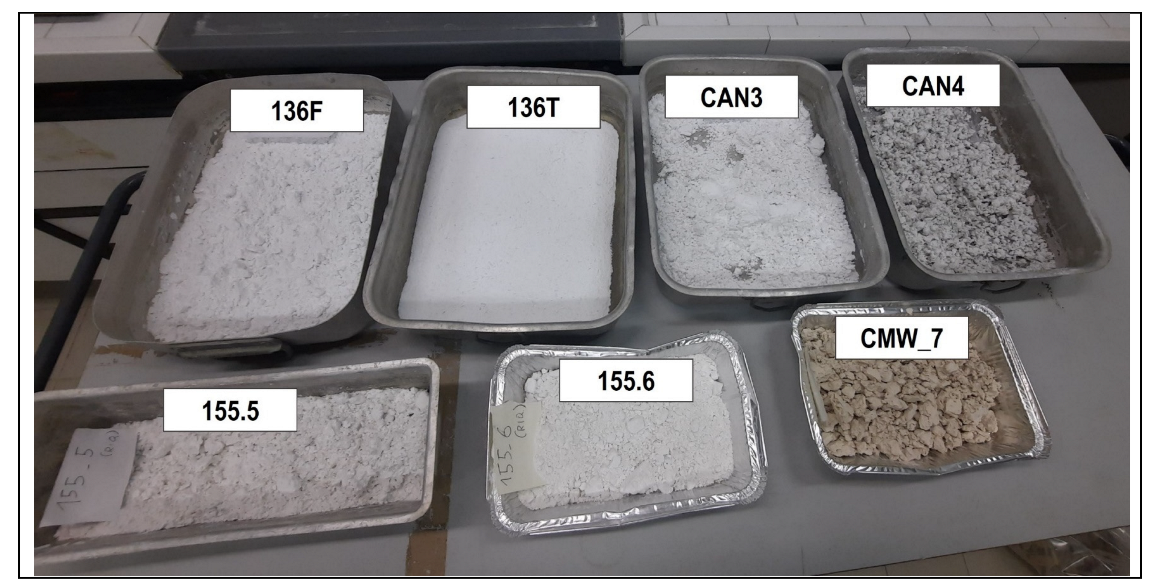
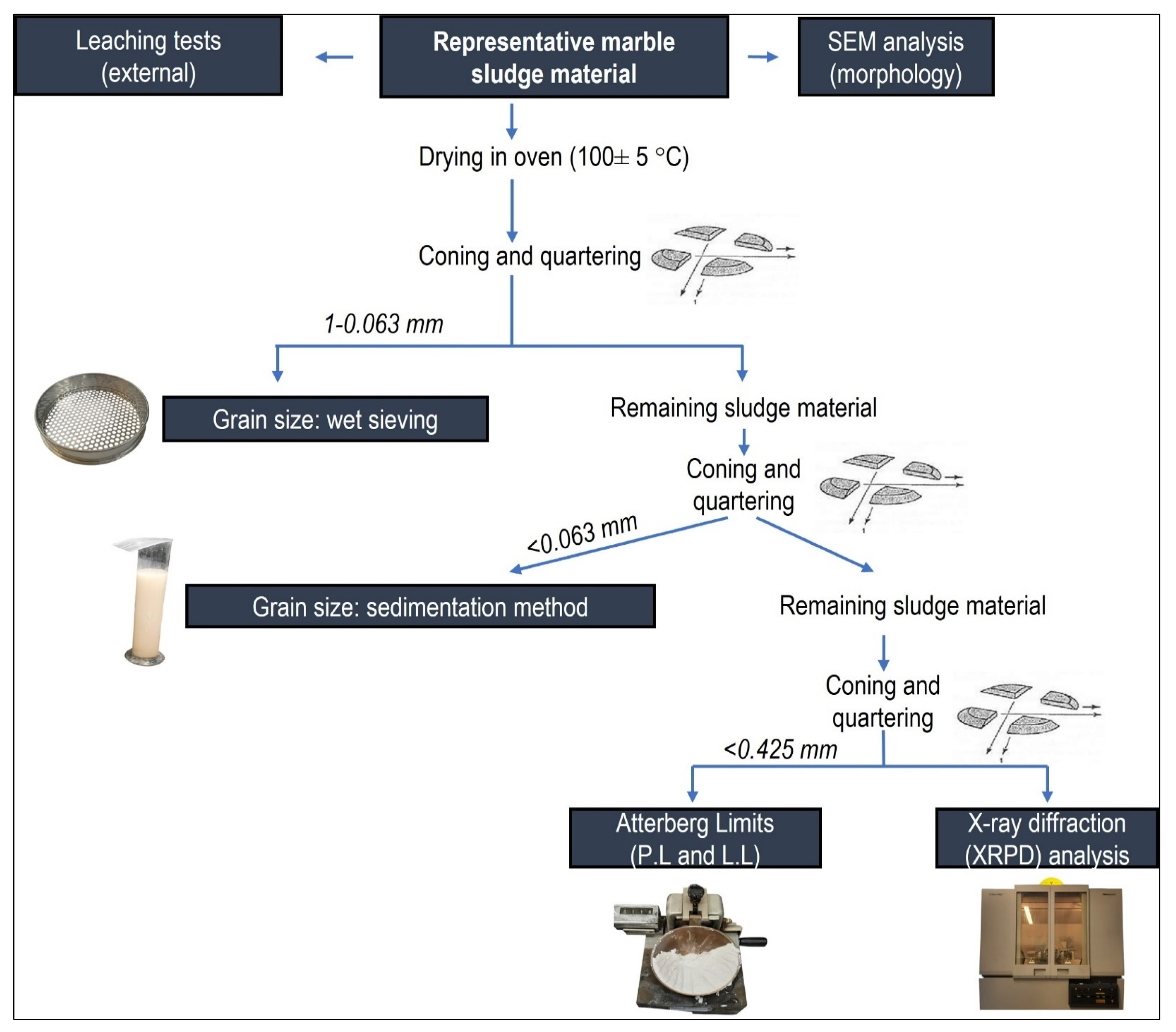
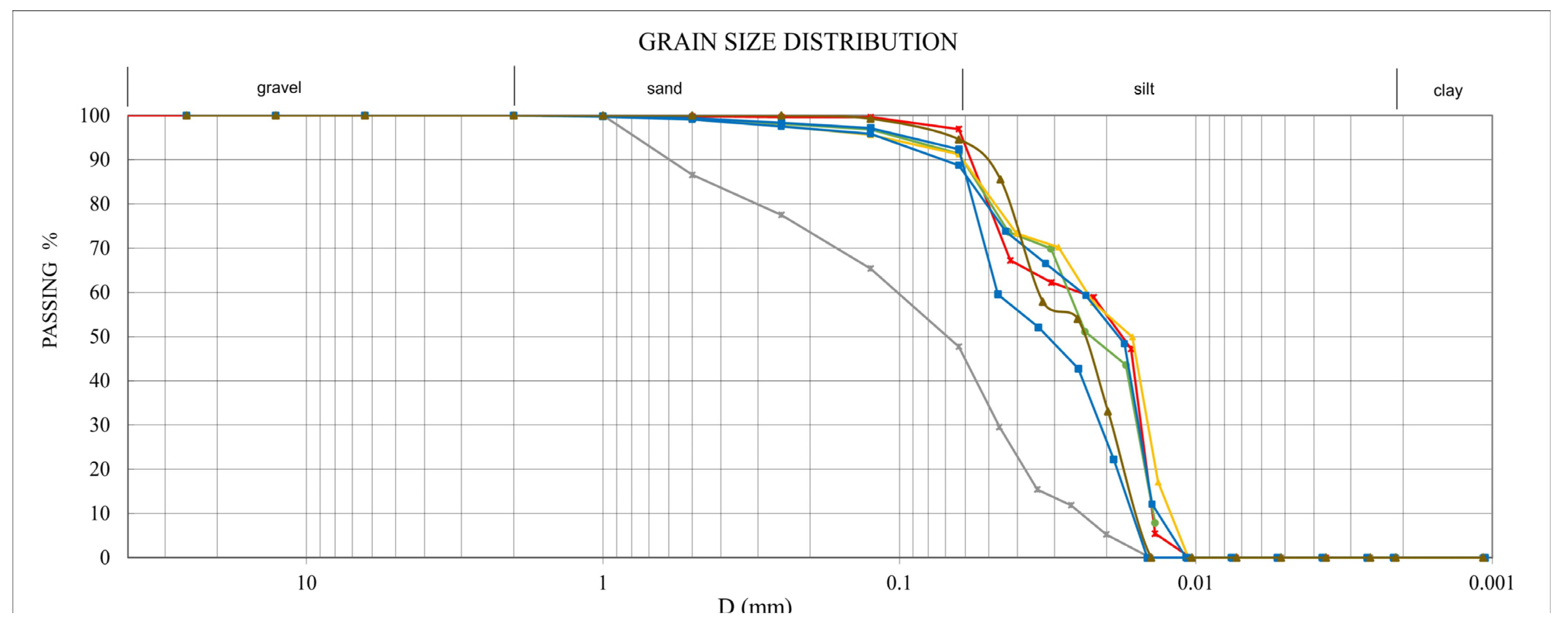

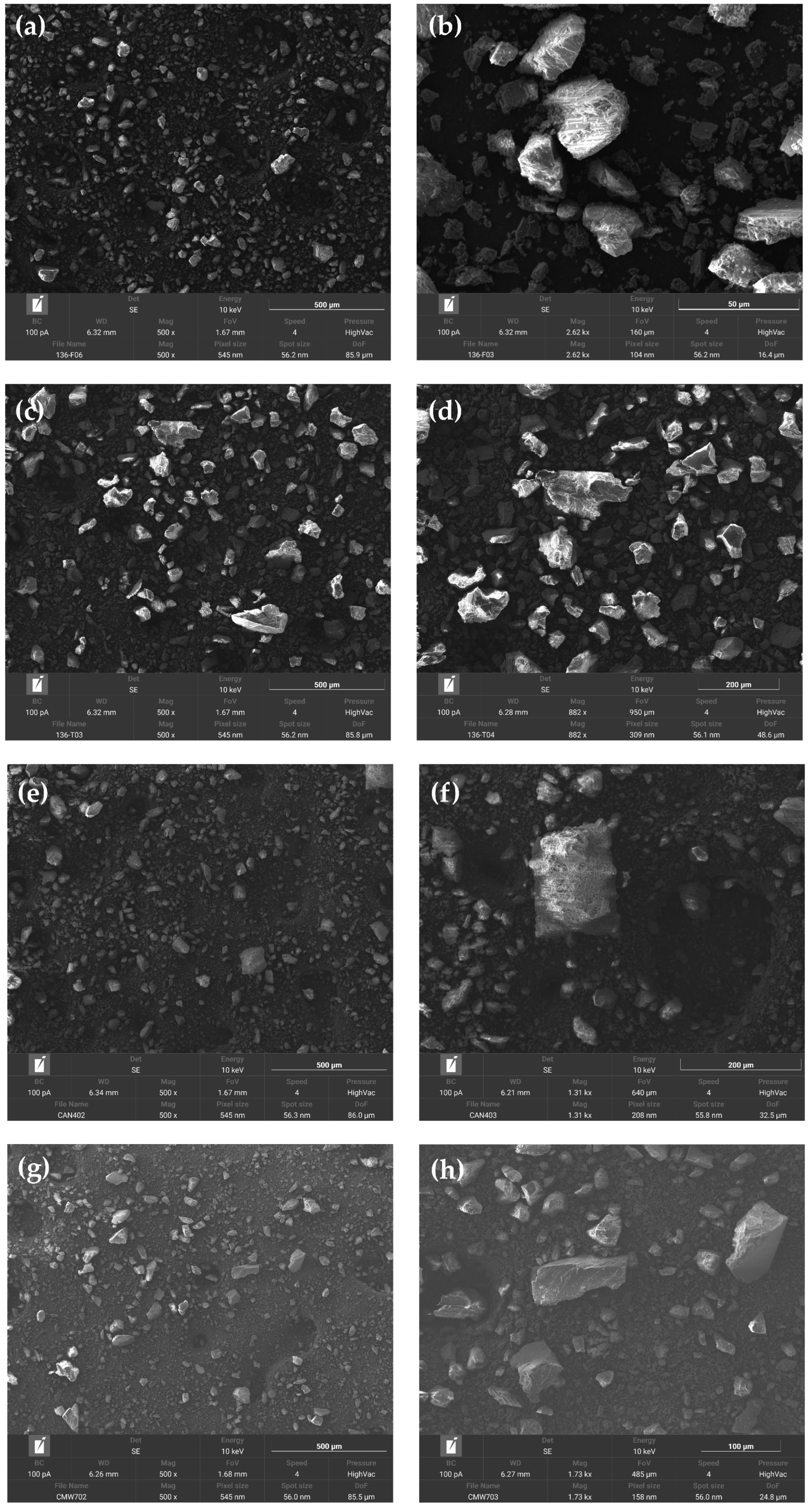
| Parameter | Value |
|---|---|
| CaCO3 [%] | >95 |
| Brightness ISO [%] | 80–96 |
| Average particle size [μm] | <3 |
| Particle size < 2 μm [%] | 2–20 |
| GCC solids content [%] | 75–78 |
| Parameter | Value |
|---|---|
| d50 [μm] | 0.7–5.0 |
| CaCO3 [%] | 98.5 |
| SiO2 [%] | 0.1–0.4 |
| Fe2O3 [%] | <0.08 |
| Specific gravity [g/cm3] | 2.7 |
| Particle size < 10.5 μm [%] | 82–90 |
| Parameter | Value |
|---|---|
| Appearance | White to light grey powder |
| Specific gravity [g/cm3] | 2.7 |
| Fineness—150 μm [%] | 100 |
| Fineness—45 μm [%] | >95 |
| Fineness: Residue at 40 microns [%] | <0.5 |
| Loss in mass at 105 °C [%] | <0.5 |
| Loss on ignition [%] | 43.50 ± 1.5 |
| CaCO3 [%] | >92 |
| Cu [%] | <0.005 |
| Mn [%] | <0.05 |
| Particle size < 10.5 μm [%] | 82–90 |
| Physical Characteristics | Value |
|---|---|
| Bulk density | 2688 kg/m3 |
| Simple compression strength | 1209 kg/cm3 |
| Compression strength after freezing | 1181 kg/cm3 |
| Indirect tensile strength (Brazilian test) | 174 kg/cm3 |
| Impact strength test | 73.8 cm |
| Moisture absorption | 0.16% |
| Sample n° | Type of Material (Marble Sludge) | Source/Location |
|---|---|---|
| 136F | sludge from diamond wire machine cutting | quarry |
| 136T | sludge from chainsaw machine cutting | quarry |
| CAN3 | sludge from processing and marble squaring | working plant |
| CAN4 | sludge from treatment operations (filter pressed/dewatered sludge) | working plant |
| 155.5 | sludge from processing and marble squaring | quarry |
| 155.6 | sludge from processing and marble squaring | quarry |
| CMW_7 | sludge from treatment operations (filter-pressed/dewatered sludge) | working plant/recycling plant |
| Sample n° | 136F | 136T | T | |||
|---|---|---|---|---|---|---|
| Marble Quarry Sludge (Diamond Wire Machine Cutting) | Marble Quarry Sludge (Chainsaw Machine Cutting) | Marble Quarry Sludge (Backhoe Machine Cutting) 1 | ||||
| Parameter | Mass Unit | Law Limit | Quantification Limit | Result | Result | Result |
| Residue at 105 °C | % | - | - | 79.2 | 100 | 100 |
| pH | unit of pH | 5.5–12 | - | 8.1 | 8.1 | 8.1 |
| Carbonates (CaCO3) | %s. s | >85 | 0.5 | 94 | 92 | 95 |
| As | μg/L | <50 | 5 | NV | NV | NV |
| Ba | μg/L | <1000 | 50 | NV | NV | NV |
| Be | μg/L | <10 | 2 | NV | NV | NV |
| Cd | μg/L | <5 | 1 | NV | NV | NV |
| Co | μg/L | <250 | 10 | NV | NV | NV |
| Tot. Cr. | μg/L | <50 | 5 | NV | NV | NV |
| Ni | μg/L | <10 | 2 | NV | NV | NV |
| Hg | μg/L | <1 | 0.5 | NV | NV | NV |
| Pb | μg/L | <50 | 5 | NV | NV | NV |
| Cu | mg/L | <50 | 5 | NV | NV | 13 |
| Se | μg/L | <10 | 5 | NV | NV | NV |
| V | μg/L | <250 | 10 | NV | NV | NV |
| Zn | μg/L | <3000 | 10 | NV | NV | NV |
| Cyanurium | ug/L | <50 | 10 | NV | NV | NV |
| Chlorides (Cl−) | mg/L | <100 | 10 | NV | NV | NV |
| Fluoride (F−) | mg/L | <1.5 | 0.2 | 0.39 | 0.44 | 0.47 |
| Nitrate (NO3−) | mg/L | <50 | 5 | NV | NV | NV |
| Sulphates (SO4) | mg/L | <250 | 10 | 10 | 14 | 23 |
| Asbestos | mg/L | <30 | Not applicable | NV | NV | NV |
| C5–C9 hydrocarbons | mg/kg | - | 5 | NV | NV | NV |
| C10–C40 hydrocarbons | mg/kg | - | 50 | NV | 479 | NV |
| Sample n° | 155.5 | 155.6 | ||||
|---|---|---|---|---|---|---|
| Sludge from Processing and Marble Squaring (Quarry) | Sludge from Processing and Marble Squaring (Quarry) | |||||
| Parameter | Mass Unit | Result | Parameter | Mass Unit | Law Limit | Result |
| Dry residue at 105 °C | % | 76.2 | Dry residue at 105 °C | % | - | 76.2 |
| Fluoride (F−) | mg/L | - | Fluoride (F−) | mg/L | 1.5 | <0.50 |
| Sulphates (SO4) | mg/L | - | Sulphates (SO4) | mg/L | 250 | 6.2 |
| Chlorides (Cl−) | mg/L | - | Chlorides (Cl−) | mg/L | 100 | 10 |
| Nitrate (NO3−) | mg/L | - | Nitrate (NO3−) | mg/L | 50 | <1 |
| Al | mg/kg | <400 | Al | - | - | - |
| As | mg/kg | <10 | As | μg/L | 50 | <2.0 |
| Ba | mg/kg | <40 | Ba | mg/L | 1 | <0.020 |
| Cd | mg/kg | <5.0 | Cd | μg/L | 5 | <0.20 |
| Co | mg/kg | - | Co | μg/L | 250 | <2 |
| Tot. Cr. | mg/kg | <10 | Cr. | μg/L | 50 | <2.0 |
| Cr VI | mg/kg | <0.50 | Cr VI | - | - | - |
| Fe | mg/kg | <400 | Fe | - | - | - |
| Mn | mg/kg | <100 | Mn | - | - | - |
| Hg | mg/kg | <5.0 | Hg | μg/L | 1 | <0.10 |
| Ni | mg/kg | <20 | Ni | μg/L | 10 | <0.20 |
| Pb | mg/kg | <50 | Pb | μg/L | 50 | 0.30 |
| Cu | mg/kg | <10 | Cu | mg/L | 0.05 | <0.0025 |
| Sb | mg/kg | <50 | Sb | - | - | - |
| Se | mg/kg | <50 | Se | μg/L | 10 | 0.26 |
| Sn | mg/kg | <100 | Sn | - | - | - |
| Tl | mg/kg | <100 | Tl | - | - | - |
| Zn | mg/kg | <20 | Zn | mg/L | 3 | 0.0022 |
| V | mg/kg | <100 | V | μg/L | 250 | <2.0 |
| Ca | mg/kg | 260,000 | Ca | - | - | - |
| Asbestos | - | - | Asbestos | mg/L | Not applicable | not detected |
| C5–C8 hydrocarbons | mg/kg | <5 | C5–C8 hydrocarbons | - | - | - |
| C10–C40 hydrocarbons | mg/kg | 1000 | C10–C40 hydrocarbons | - | - | - |
| pH | unit of pH | 9.6 | pH | unit of pH | 5.5–12 | 9.8 |
| Sample n°. | 136F | 136T | CAN3 | CAN4 | 155.5 | 155.6 | CMW_7 |
|---|---|---|---|---|---|---|---|
| Marble Quarry Sludge (Diamond Wire Machine Cutting) | Marble Quarry Sludge (Chainsaw Machine Cutting) | Sludge from Processing and Marble Squaring (Working Plant) | Sludge from Filter Press Treatment (Working Plant) | Sludge from Processing and Marble Squaring (Quarry) | Sludge from Processing and Marble Squaring (Quarry) | Sludge from Filter Press (Working Plant/Recycling Facility) | |
| water content % | 15.5 | 1.9 | 22.2 | 19.9 | 16.9 | 2.7 | 20.0 |
| % particles < 63 um (silt) | 97.0 | 29.5 | 91.4 | 91.3 | 92.3 | 88.6 | 85.5 |
| % particles < 2 um (clay) | n.f | n.f | n.f | n.f | n.f | n.f | n.f |
| Uniformity (U) | 1.7 | 6.7 | 1.8 | 1.9 | 2.6 | 1.7 | 2.2 |
| Grain size classification | silt | silty sand | weakly sandy silt | weakly sandy silt | weakly sandy silt | sandy silt | weakly sandy silt |
| L.L | n.d | n.d | n.d | n.d | 20 | 23 | 20 |
| P.L | n.d | n.d | n.d | n.d | 18 | 20 | 18 |
| P.I. | n.d | n.d | n.d | n.d | 2 | 3 | 2 |
| CaCO3 % (from XRD) | 96 | 92 | 96 | 83 | >95 | >95 | 91 |
Disclaimer/Publisher’s Note: The statements, opinions and data contained in all publications are solely those of the individual author(s) and contributor(s) and not of MDPI and/or the editor(s). MDPI and/or the editor(s) disclaim responsibility for any injury to people or property resulting from any ideas, methods, instructions or products referred to in the content. |
© 2024 by the authors. Licensee MDPI, Basel, Switzerland. This article is an open access article distributed under the terms and conditions of the Creative Commons Attribution (CC BY) license (https://creativecommons.org/licenses/by/4.0/).
Share and Cite
Tazzini, A.; Gambino, F.; Casale, M.; Dino, G.A. Managing Marble Quarry Waste: Opportunities and Challenges for Circular Economy Implementation. Sustainability 2024, 16, 3056. https://doi.org/10.3390/su16073056
Tazzini A, Gambino F, Casale M, Dino GA. Managing Marble Quarry Waste: Opportunities and Challenges for Circular Economy Implementation. Sustainability. 2024; 16(7):3056. https://doi.org/10.3390/su16073056
Chicago/Turabian StyleTazzini, Antonio, Francesca Gambino, Marco Casale, and Giovanna Antonella Dino. 2024. "Managing Marble Quarry Waste: Opportunities and Challenges for Circular Economy Implementation" Sustainability 16, no. 7: 3056. https://doi.org/10.3390/su16073056
APA StyleTazzini, A., Gambino, F., Casale, M., & Dino, G. A. (2024). Managing Marble Quarry Waste: Opportunities and Challenges for Circular Economy Implementation. Sustainability, 16(7), 3056. https://doi.org/10.3390/su16073056







